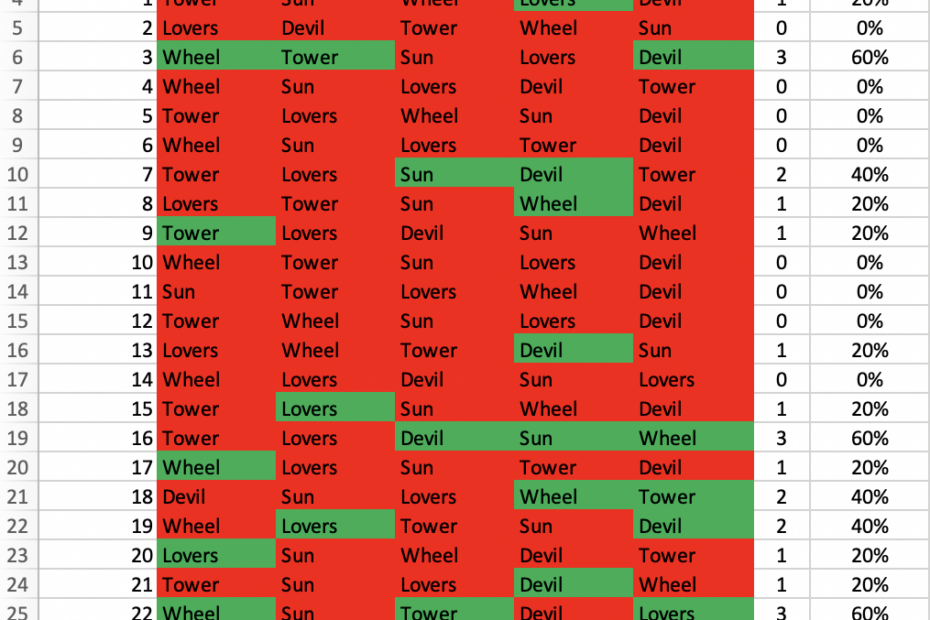Experiment I conducted for my Atlantic University TP6100 Course – February 5, 2020.
On Wednesday, February 5, 2020, at approximately 12:00 pm ET, I conducted a 25-trial psi experiment using 5 Rider Waite Tarot Cards. I selected two cards that were positive (The Lovers & The Sun), two cards that are generally perceived as negative (The Devil & The Tower), and 1 neutral card (Wheel of Fortune). Each trial consisted of me shuffling the five cards and then dealing them face down next to each other as pictured below.

I began thinking about what order the five cards would appear as I dealt the cards. I focused for a moment and then recorded my guesses in a spreadsheet I developed for the experiment. Once I inputted my guess, I turned each of the cards over like so:

Each of the 25 trials consisted of attempting to guess the correct order that the five tarot cards would appear. I used a green background to highlight hits, and a red background to denote misses. I then recorded the number of hits for each trial in the next cell and calculated a percentage correctly guessed by using the number in the hit column divided by 5. I repeated this process 25 times.
I had 27 correct guesses over the course of the 25 trials, or a 22% hit rate (27 hits divided by 125 cards drawn). I did not guess 5 out of 5 in any of the trials. It’s impossible to guess 4 out of 5 since if one is off, another must be as well. In three trials I correctly guessed 3 cards, in five trials I scored 2 hits, in 8 trials the hit rate was 1, and in 9 trials I didn’t guess any correctly. The results appear below.

I’m not sure if this speaks to my subconscious, but I guessed The Devil in the correct position the most with 7 hits, closely followed by The Lovers and Wheel of Fortune cards with 6 hits. I correctly guessed The Tower’s position correctly in 5 trials, and the Sun received the least amount of hits at 3.
Ensuring a Clean Experiment
I attempted to limit the number of psi influences by conducting the experiment myself, and I conducted it alone. I suppose this doesn’t guarantee that I didn’t try to gain an advantage for myself, but I tried to eliminate this by quickly and efficiently recording my guesses before turning the cards over. Unlike when I draw cards for myself sometimes, none of them flipped over or onto the floor by mistake. If one had, I would have redone the trial by reshuffling and laying the cards out.
I did have Pandora playing in the background in the beginning, and decided to turn off the music. I found it distracting and therefore thought it might skew the results downward. I also used a big enough surface so that I wasn’t negatively impacted by an inability to layout the card.
One issue I did grapple with is that once I did a few trials, my spreadsheet for some reason kept defaulting to the red background every time I typed in a guess. I found this annoying and sent off bad vibes since the color meant a miss. After unsuccessfully trying to clear the automatic red fill (thanks Microsoft), I recorded the guesses far enough below the previous guesses where there was no fill, and once I recorded the 5 guesses, I dragged it to the appropriate trial number.
I hope the fact that I conducted the experiment on my own eliminated the potential for cheating and fraud. The less than stellar results also speak to the fact no cheating occurred. If I was, I’d sure be hoping for a lot better hit rates!
With the limited number of trials I conducted it’s certainly not enough to make a legitimate experiment. The odds against chance are completely out of my league, but from the experiments we’ve read thus far, I know only a small margin above chance is significant. For example, one of the first RNG ESP tests Richard Broughton references indicates that a hit rate of 26%, or 1% above chance of 25% “may not seem too spectacular until you realize that the statistical odds against this happening by chance are more than 100 million-to-one” (1991, p. 124).
Since I was the observer, recorder, and subject, I took my time with the trials. Turning the music off helped, and I took some time to find a work-around for the red-fill issue. I found it annoying enough that I didn’t want to have to stop between each trial to fix it so I came up with the solution of recording it below and dragging the 5 results up en masse.
Setting up a formula ahead of time helped to ensure that the percentage of hit rate was recorded accurately – as long as the actual number of hits was inputted correctly. I double-check each the number before actually recording it. I tallied the final results by hand as well as using Xcel’s “Sum” function for the column. And finally, I used two methods to calculate the final result of 22%. The first was to take the total number of hits (27) and divide it by 125 ( 5 cards x 25 trials). I also used the “Sum” function again for the percentage hit column and then divided that result by the 25 trials and reached the same result.
ReferencesBroughton, R. (1991). Parapsychology: the controversial science. New York, NY: Ballantine Books.989 words Average of ratings: –Permalink | Reply
